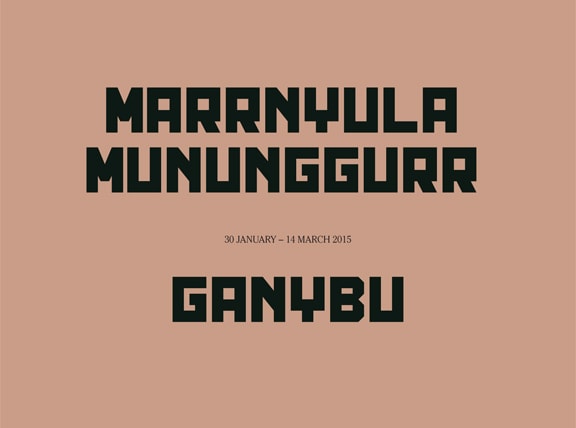programs

MARRNYULA MUNUNGGURR: GANYBU
Download catalogue here.
Ganybu is Yolngu-Matha for fish net. Marrnyula Mununggurr’s exhibition titled Ganybu comprises 252 small barks and one larrakitj (ceremonial pole), each of which depict her Djapu clan design of the fish net and the waters at her ancestral homeland at Wändawuy in North East Arnhem Land. Mununggurr’s miny’tji (designs) comprise vertical and horizontal lines that reference the structure of the net, and diagonal or crosshatched lines that reference water in various states (fresh water — moving, like in a river; muddy; or still, like a pond). They are painted with a fine hair-brush and naturally occurring earth pigments — white clay (also used for body paint and bunggul), black manganese, yellow and red stones — mixed with water and fixative to form a fluid pigment.
Along with her sister, the artist Rerrkirrwanga Mununggurr, Marrnyula learned to paint from her late father (the artist Djutjadjutja Mununggurr) and his brother when she was about fifteen or sixteen years old: first by watching them paint, then by painting on small barks and helping them on their larger barks. While she never met her paternal grandfather, the renowned Djapu clan leader Wonggu Mununggurr, the shimmering, gridded and diagonal designs of his crayon on butchers paper drawings of the fish trap (such as Fish trap at Wändawuy, 1947) resound immortal in her paintings. Today, she frequently works with her mother, the artist Nonggirrna Marawili, who has also painted the fish net.
Having worked at Buku-Larrnggay Mulka Centre in Yirrkala now for twenty-one years, Mununggurr’s practice is diverse — ranging from soft-ground etchings of Yolngu string figures, such as those made in collaboration with visual anthropologist Robyn McKenzie now held in the collection of the National Gallery of Victoria, to community posters, such as her well-known AIDS awareness design If you love me love me safely from 1993, commissioned by Northern Territory Health and Community Services.
Mununggurr has also painted large, figurative, story barks. She produced one, for instance, for the landmark Saltwater exhibition of 1999, held in celebration of the 1998 Federal Court ruling that native title existed over a 2,000-square kilometre area of sea and sea-bed adjoining Croker Island (and associated islands) in the Northern Territory.1 This was the first time that Australian Courts recognised native title for off-shore areas, a landmark in the history of Indigenous Australian landrights. Mununggurr’s contribution to Saltwater, a 111 x 96 cm bark titled Living by the Sea of 1998, depicts Yolngu people, dogs, birds, trees, spears, canoes, paddles, fish, turtles, sting rays, and dugong, and shows, in the artist’s words, that ‘we are all connected to the sea through stories and hunting for food’.2 The small barks of Ganybu are approximately a tenth of the size of Living by the Sea (indeed many of the small barks come from a single sheet of bark from gadayka — Eucalyptus tetrodonta, or stringy bark), making them ‘good for packing’ and ‘easy to move’.3 There may also be a connection with the artist’s memories of learning to paint.
After experimenting with different configurations of the barks on the floor of the gallery, Mununggurr arranged the 252 small barks of Ganybu into a vast installation spanning approximately 4 metres high, and 6.5 metres wide — the entire breadth and height of the wall of the front gallery at Gertrude Contemporary. The central, inverted triangular configuration of barks refers to the shape of a hand-held, pelican-mouthed ganybu made of two branches interlocked at one end, open at the other, and laced with string. Two horizontal lines made from two rows of small barks flank this central shape, and it is crowned by a solitary, arching line that echoes the open mouth of ganybu.
Mununggurr explains that Yolngu have used this ganybu for a long time to catch catfish during the dry season: this ganybu ‘is not a balanda net but Yolngu.’ She adds that ganybu has metaphorical connotations too: ‘to grab people or bring them and show them our culture, Yolngu people, including balanda [westerner, or non-Aboriginal people]… they never know what ganybu means… That’s why I named the bark ganybu, so that people can come and see.’ Directly facing the floor-to-ceiling windows that line the front gallery, Mununggurr’s graphic installation makes a direct address to passers by on Gertrude Street, inviting them inside.
Upon entering, viewers step into a deeply interconnected environment: stories of the net and waters at Wändawuy homeland are cross-referenced across each of the individual 252 barks of the wall-mounted installation, the ganybu shape of the installation itself, and the miny’tji adorning the larrakitj. Further, large bark shavings that were stripped from the larrakitj as it was prepared for painting are scattered across the entire gallery floor to create a pungent carpet. The scent of eucalyptus and the texture of the stringy bark underfoot serve to ‘show balanda that the bark [paintings] and larrakitj all come from the same tree.’ The installation is a powerful reminder that, as Andrew Blake — former Art Coordinator at Buku-Larrnggay — has said, everything in traditional Yolngu life is connected: ‘Every physical or meta-physical thing has a place on a complex but ordered grid.’4
1. Djon Mundine, ‘Saltwater’, in Saltwater: Paintings of Sea Country, the Recognition of Indigenous Sea Rights [1999], second edition, ed. Jenny Isaacs, Carol Dettmann, Andrew Blake, Will Stubbs, Raymattja Marika, Djambawa Marawili, Gawirrin Gumana, Dhukal Wirrpanda, Merrkiyawuy Ganambarr (Neutral Bay, NSW: Chapter and Verse, 2014), p. 26. Mundine cites: Mary Yamirr and Others v. Northern Territory, Olney J, 1998, 771, Federal Court of Australia.
2. Marrnyula Mununggurr, cited Saltwater, [1999] 2014, p. 44.
3. Marrnyula Mununggurr, interview with the author, 28 January 2015. All otherwise unattributed information and quotations come from this interview.
4. Andrew Blake, preface to Saltwater, [1999] 2014, pp. 6–8.